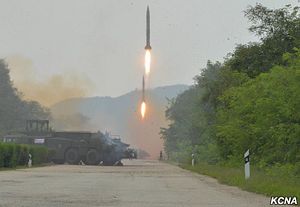On Monday, as world leaders of the Group of 20 met in Hangzhou, China, North Korea made a typically dramatic show of force by launching three ballistic missiles from Hwangju county in the country’s southwest into the Sea of Japan. The missiles flew for around 1,000 kilometers and entered Japan’s air defense identification zone, according to South Korea’s Joint Chiefs of Staff. The test continues Pyongyang’s ongoing spate of missile testing this year, which has seemingly carried on unabated since the spring.
When Pyongyang released footage and images of this week’s launch, however, it became quickly clear to North Korea watchers that the missiles here were something new, even though the launchers appeared similar to those Pyongyang uses for its Scuds. Pyongyang has spent most of the year testing its Hwasong-10 (Musudan) intermediate-range ballistic missiles and Hwasong-7 medium-range ballistic missiles. Both platforms have been tested this summer, in addition to the KN-11 submarine-launched ballistic missile, which drew headlines in August.
After analyzing the images released by the North Koreans, experts at the Center for Nonproliferation Studies at the Middlebury Institute of International Studies at Monterey believe that North Korea showed off its extended range (ER) Scud missile. Because North Korea hasn’t flown or shown off the Scud-ER, the system has received fairly limited attention. The 2016 U.S. Department of Defense report on North Korea’s military notes the existence of the system alongside the regularly tested Scud-B (Hwasong-5), Scud-C (Hwasong-6), and the shorter-range Toksa.
The ER is a variation on the Scud-C with an elongated fuselage to store additional fuel. According to CNS’ Jeffrey Lewis, the pictures released by North Korea suggest that the launchers use a slightly larger cradle, but appear to otherwise be the same kind that Pyongyang uses for other missile launches. The Scud-ER is thought to be capable of delivering a 500 kg payload to roughly 1,000 km, Lewis adds. The payload is considerably reduced from the Scud-C–a trade-off that allows for a longer-range delivery.
This week’s decision to show off the Scud-ER during the G20 has important value for North Korea politically. Melissa Hanham, also of CNS, notes that Pyongyang may have decided to advertise the Scud-ER now “because they can produce a lot more of them than longer range [missiles].” Given the decision earlier this summer by the United States and South Korea to deploy the Terminal High Altitude Area Defense system, Pyongyang is likely eager to emphasize its capability to saturate any allied missile defense capability with its existing missiles.
For instance, Monday’s test showed off North Korea’s ability to launch three ballistic missiles within a minute, a show of force intended to hint at the possibility of saturating the capabilities of South Korea’s planned THAAD battery. Though the precise limitations of THAAD are classified, an analysis published earlier this year estimates that a North Korean launch of “more than 20 missiles simultaneously” would overwhelm THAAD’s fire-control radar. The U.S. Department of Defense estimates that North Korea has “fewer than 100” launchers for its Scud variants.
Essentially, this week appears to have been the coming out party for North Korea’s Scud-ER. In the broader strategic context of the Korean peninsula, Pyongyang has gone to lengths this year to show Washington and Seoul that it’s making steady progress on previously untested and unproven platforms like the Hwasong-10, the KN-11, and now the Scud-ER. Pyongyang wants the world to know that even with missile defense plans inching ahead on the other side of the 38th parallel, it’s got a broad enough toolkit to keep the heat high.

































